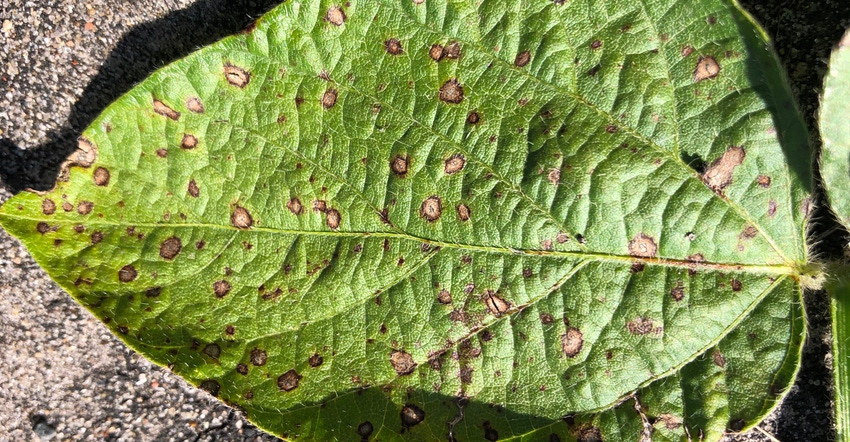
Warm, humid conditions and frequent rains are prime circumstances for the fungal disease frogeye leaf spot to occur in soybean fields.
Frogeye leaf spot usually shows up on leaves. Lesions start as small dark spots that turn to a tan color and are surrounded by a darker reddish-brown or purple ring. Lesions may also damage large areas of the leaves and result in defoliation.
The disease, which has the potential to cause significant yield loss, has been reported with increasing frequency and distribution in Minnesota over the past two years. Soybean yield losses up to 35% have been reported in the central and southern U.S.
Keep in mind these four facts about frogeye leaf spot, offered by University of Minnesota plant pathologist Dean Malvick:
1. When it occurs. Frogeye leaf spot can occur at any time during the growing season. Mostly it occurs after flowering. Young leaves on the top part of plants are most susceptible.
2. How to control it. Make sure you use the right fungicide. Frogeye leaf spot has been shown to have resistance to strobilurin fungicides in most of the U.S. That resistance was confirmed in three Minnesota counties in 2019. If you need to apply fungicides to manage the disease, use mixtures with a sufficiently high level of active ingredients other than strobilrins. Fungicide information is available from the Crop Protection Network.
3. How persistent it is. The frogeye leaf spot fungus has been reported to survive in infected soybean leaves for at least two years. Thus, crop rotation and tillage can help to reduce it.
4. Where it’s been found. Frogeye leaf spot has been reported most frequently in the southern quarter of Minnesota this year and over the past two years. It has also been reported in central Minnesota. It could occur on soybeans across the state.
Malvick would like growers to report if they have seen frogeye leaf spot so scientists can track its development across the state and to see if fungicide resistance is widespread. Please take digital photos and email them, along with location information, to Malvick at [email protected].
Malvick also asks growers to send samples to the U-M Plant Disease Clinic lab for analysis. A limited number of tests will be paid for by Minnesota Soybean and free to farmers. Make sure Malvick’s name is on the outside of the envelope. Information about the lab is available at pdc.umn.edu.
About the Author(s)
You May Also Like






